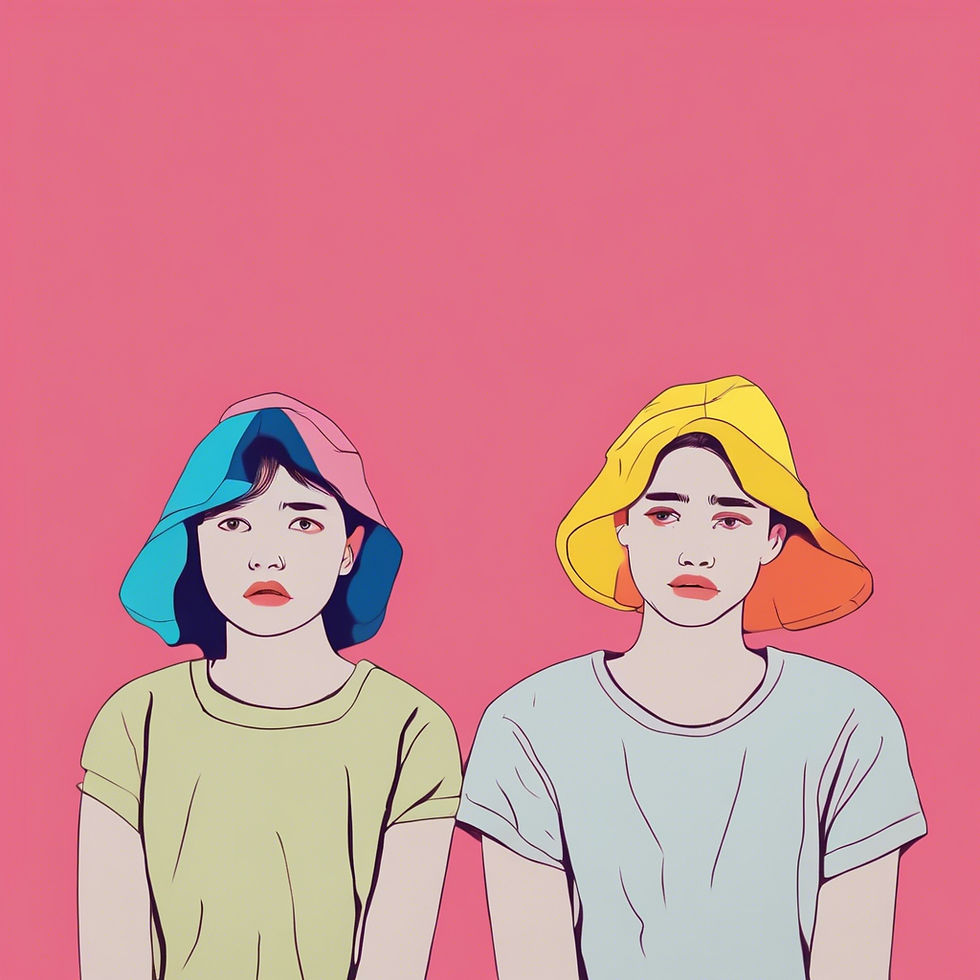What is millennial art about today?
- ALEKS
- Dec 29, 2024
- 4 min read
“We are a sad generation with happy pictures,” said a quote I stumbled upon on Instagram or Pinterest a few years ago. It struck me how painfully real it is. How we “sell” a perfect image of ourselves and our lives online while struggling with all sorts of issues behind closed doors. For what?
Then I remembered an old Polish saying, often heard at weddings or big family gatherings: zastaw się a postaw się—loosely translating to “stretch yourself thin to impress others.” Growing up in Poland, I never thought this mindset was universal. But seeing Instagram today, it seems like it’s become global. Or maybe it always was.
So, what does this have to do with art? Well, I strongly believe that one of art’s purposes is to reflect the times we live in—a mirror for the present and, for future generations, an unfiltered history book. That’s exactly the goal of the upcoming exhibition series at ELEVEN TEN STUDIO: to take that phrase, “sad generation with happy pictures,” and use it to explore not just artistic practices but also our current societal state, relationships, and all aspects of millennial life.

Who are millennials?
Millennials, born roughly between the early 1980s and mid-1990s, are often referred to as the “in-between” generation. We bridge two worlds: the analog childhood of cassette tapes and landlines and the digital adulthood of smartphones and social media. Monumental events shaped us—the fall of the Berlin Wall, the 9/11 attacks, the 2008 financial crisis. We long for stability yet are swept up in the relentless pace of change.
Dubbed the “Ikea generation,” our lives are modular, impermanent, and often precarious. This tension between inherited progress and existential uncertainty defines us—not just as people, but as creators and consumers of art.
Eastern vs. Western
Growing up in Poland, the world felt divided into two: “home” and zagranica (abroad). Poland, like much of Eastern Europe, carried the weight of history—decades of communist rule, post-Soviet transitions, and the struggle to rebuild. Zagranica was a dream: opportunity, freedom, progress. At home, things felt more limited, shaped by economic and cultural divides.
Today, these borders have faded—at least on the surface. Poland is part of the EU; the Iron Curtain is a distant memory. But that division, that lens of “us vs. them,” still shapes how many of us see the world. It’s shaped me and my art practice. My experience of rapid transformation feels starkly different from the steadier trajectories of my Western European peers.
This difference shows up in art too. Artists from Eastern Europe often bring a rawness and urgency to their work, reflecting the upheaval of their environments. Take Agnieszka Polska, whose video piece The New Sun (2017) explores collective memory and ecological crisis with surreal, poetic visuals. Or Paweł Althamer, whose community-driven projects blur the line between personal and collective experience.
In Western Europe, where stability was more accessible, millennial artists like Anne Imhof focus on institutional critique and polished, conceptual aesthetics. Her performance piece Faust (2017), which won the Golden Lion at Venice, is a perfect example—a dystopian meditation on power and alienation. Together, these artists embody the millennial ethos: fluid, collaborative, and boundary-breaking.
Millennials as collectors
Millennials aren’t just creating art—we’re transforming the art market as collectors too. Unlike previous generations, we prioritize values over status. We’re more likely to buy works from emerging artists or diverse voices rather than chasing blue-chip names. The rise of platforms like Black Art in America, which connects collectors with Black artists, reflects this shift.
We also love technology. Blockchain-based platforms like SuperRare have made digital art and NFTs accessible, empowering artists and buyers alike. For example, collectors like Justin Sun, the founder of TRON, have spent millions on NFTs, while others support physical works tied to strong personal narratives.
Millennials crave experiences over ownership, driving the popularity of immersive installations. Think Yayoi Kusama’s Infinity Rooms, which became Instagram sensations, or interactive digital spaces created by artists like Tabor Robak, whose hyperreal landscapes critique consumerism and gaming culture.
A generation in duality
“Sad generation with happy pictures” perfectly captures the paradox of millennial life. Outwardly, we present curated perfection, but underneath, there’s anxiety, loneliness, and a deep craving for authenticity. And while the East-West divide may be fading, new binaries have emerged: the unfiltered vs. the digital utopia. The world thrives on opposites—good and bad, rich and poor, real and fake—always comparing and judging. As artists, we use these tensions as fuel, creating works that reflect the fractures and contradictions of our time.
ELEVEN TEN STUDIO's 2025 Half-Year Program
The upcoming exhibition series at ELEVEN TEN STUDIO dives headfirst into these millennial contradictions. Over four solo exhibitions, artists Duncan Passmore, Matthias Amsler, Luca Harlacher and Viviane Herzog will explore themes like connection vs. isolation, nostalgia vs. innovation, and precarity vs. progress.
It’s not just a showcase of art—it’s a dialogue. Through these works, we’ll reflect on how generational shifts are shaping not just creativity but the markets and narratives around it. The program is an invitation to explore the tensions, complexities, and dualities of millennial life—no filters, just raw reality refracted through art.
Aleksandra Cegielska, curator




Comentários